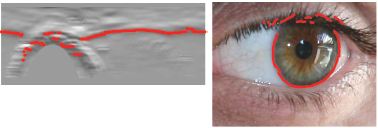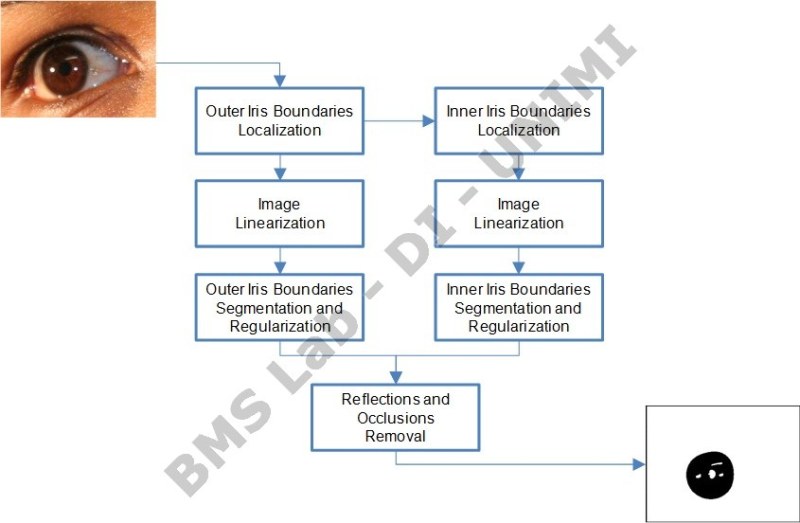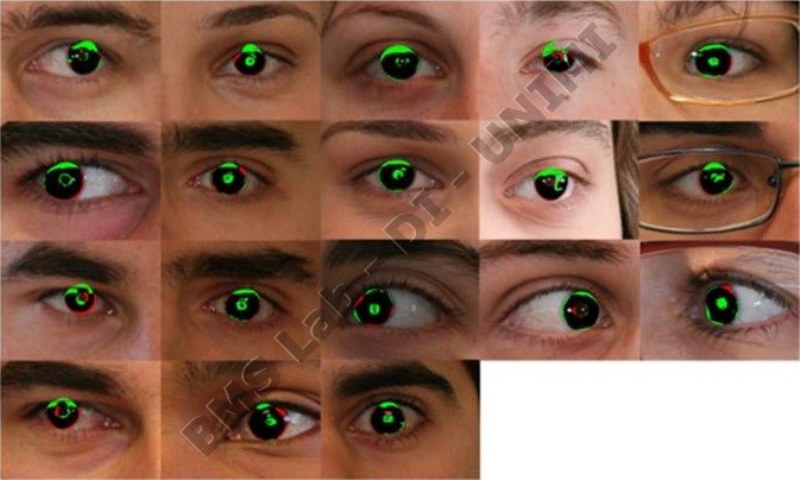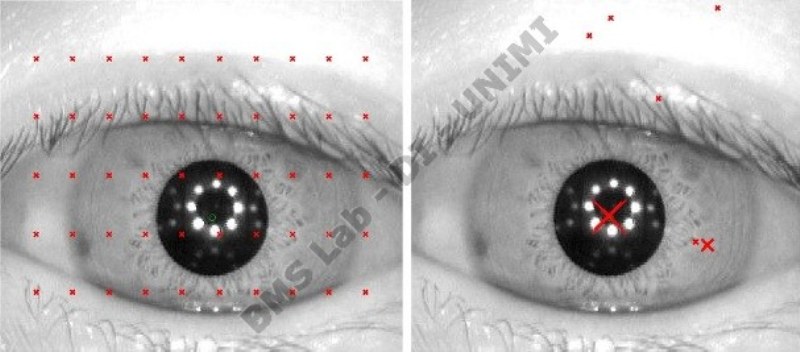Iris Recognition in Unconstrained Applications
Some biometric traits can be captured by using technologies that does not require the contact of the user with a sensor. Theoretically, it is possible to design biometric systems that capture these traits without subjects' knowledge and in uncontrolled scenarios. This type of biometric systems should be useful in different applicative scenarios (e.g. police investigations, surveillance, etc.). In this context, iris is one of the most interesting biometric traits, since iris recognition systems are one of the most accurate biometric techniques. The behavior of most traditional iris segmentation algorithms is designed for controlled/low-noise environments and it is typically not satisfactory in noisy images, where specific methods are needed to successfully cope with this peculiar applicative contest. The work we propose deals with the segmentation of the iris patterns in this type of noisy images.
Polar Spline RANSAC (PS-RANSAC) for non-ideal iris segmentation

A finalist method of the interational competition NICE.I

Examples of the obtained results

Multi-agent pupil center localization

Multiple views iris boundaries refining

Software
Source code of Polar Spline RANSAC (PS-RANSAC) for non-ideal iris segmentation
https://github.com/DonidaLabati/PS-RANSAC
References
-
R. Donida Labati, A. Genovese, V.
Piuri, F. Scotti, S. Vishwakarma, "I-SOCIAL-DB: A labeled database of images collected from websites and social media for iris recognition", in Image and Vision Computing, pp. 1-9, January, 2021. ISSN: 0262-8856. [DOI: 10.1016/j.imavis.2020.104058][PDF]
-
R. Donida Labati, E. Muñoz, V. Piuri,
A. Ross, F. Scotti, "Non-ideal iris segmentation using Polar Spline RANSAC and illumination compensation", in Computer Vision and Image Understanding, Elsevier, November, 2019. ISSN: 1077-3142. [DOI: 10.1016/j.cviu.2019.07.007][PDF]
-
R. Donida Labati, A. Genovese, V.
Piuri, F. Scotti, "Iris segmentation: state of the art and innovative methods", in Cross Disciplinary Biometric Systems, C. Liu, V.K. Mago (eds.), Springer Berlin Heidelberg, pp. 151-182, 2012. ISBN: 978-3-642-28457-1. [DOI: 10.1007/978-3-642-28457-1_8][PDF]
-
R. Donida Labati, F. Scotti, "Noisy iris segmentation with boundary regularization and reflections removal", in Image and Vision Computing, Iris Images Segmentation Special Issue, Elsevier, pp. 270 - 277, February, 2010. ISSN: 0262-8856. [DOI: 10.1016/j.imavis.2009.05.004][PDF]
-
F. Scotti, V. Piuri, "Adaptive reflection detection and location in iris biometric images by using computational intelligence techniques", in IEEE Transactions on Instrumentation and Measurement, pp. 1825-1833, July, 2010. ISSN: 0018-9456. [DOI: 10.1109/TIM.2009.2030866][PDF]
-
R. Donida Labati, V. Piuri, F.
Scotti, "Neural-based iterative approach for iris detection in iris recognition systems", in Proc. of the IEEE Symp. on Computational Intelligence for Security and Defence Applications (CISDA 2009), Ottawa, ON, Canada, pp. 1-6, July 8-10, 2009. ISBN: 978-1-4244-3763-4. [DOI: 10.1109/CISDA.2009.5356533][PDF]
-
R. Donida Labati, V. Piuri, F.
Scotti, "Agent-based image iris segmentation and multiple views boundary refining", in Proc. of the 2009 IEEE Int. Conf. on Biometrics: Theory, Applications and Systems (BTAS 2009), Washington, D.C., USA, pp. 1-7, September 28-30, 2009. ISBN: 978-1-4244-5019-0. [DOI: 10.1109/BTAS.2009.5339077][PDF]
-
F. Scotti, "Computational intelligence techniques for reflections identification in iris biometric images", in Proc. of the 2007 IEEE Int. Conf. on Computational Intelligence for Measurement Systems and Applications (CIMSA 2007), Ostuni, Italy, pp. 84-88, June 27-29, 2007. ISBN: 978-1-4244-0824-5. [DOI: 10.1109/CIMSA.2007.4362544][PDF]